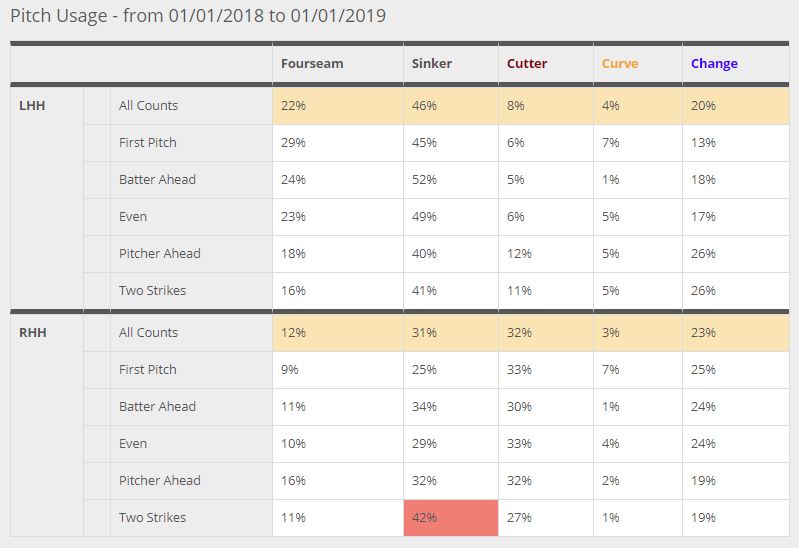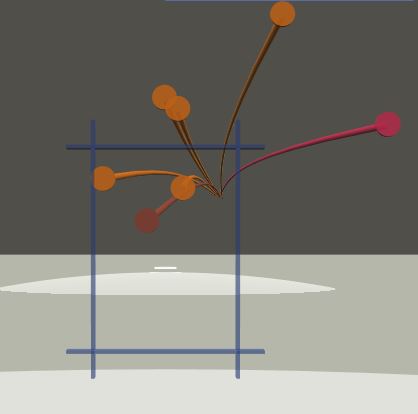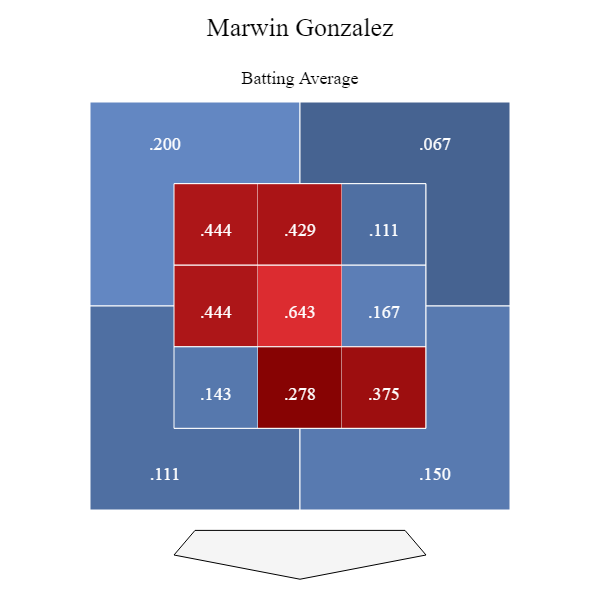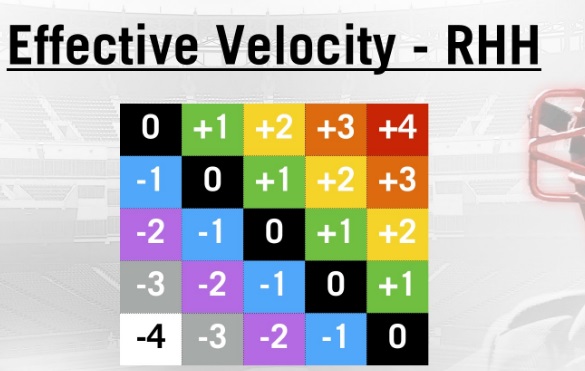(Photo by Samuel Stringer/Icon Sportswire)
During the top of the third inning in game two of the 2018 American League Championship Series, Boston Red Sox starter David Price gave up a home run to Houston Astros outfielder Marwin Gonzalez. That damage put the Astros in front early and shifted the win probability in favor of Houston by 67%. Of course, Boston would come back and win the game, tying the series 1-1 as the best-of-seven heads to Houston for the next three games. This might have wound up being a pivotal moment that heavily tipped the scales in favor of Houston heading to their second straight World Series had Boston not mounted a comeback. If Price was EV-aware, it could have been avoided or had the damage significantly minimized. I’m going to go over the seven-pitch at-bat and explain what Price did in terms of Effective Velocity.
Let’s take a look at Price’s tendencies versus right-handed hitters during the 2018 season.

CHART 1
As you can see in Chart 1 (from 2018), Price does a pretty good job mixing his three main pitches versus righties. The only heavily-favored pitch selection occurs with two strikes (more on that in a minute).
Below is the 3-D pitch chart for the at-bat; orange is his sinker/two-seam, brown is his cutter, and red is his four-seam.

CHART 2
Chart 2 shows Price attacked Gonzalez up (and away). Is there anything to that gameplan? Take a look at the following two zone charts.

CHART 3

CHART 4
So Gonzalez’s exit velocity is evenly spread around for the most part with the exception of zones three and four (see Chart 3). However, the pitches Price threw (in the strike zone, at least) were located where Gonzalez’s batting average has been the highest (see Chart 4).
With that in mind, let’s take a look at each pitch and its relation to the Effective Velocity zones which were created by Perry Husband; Chart 5 displays the Time Unit (TU) chart.

CHART 5
Before I get into each pitch, be aware that Price’s typical velocity on his three main pitches is as follows:
Sinker/Two-seam: 93 MPH
Changeup: 86 MPH
Cutter: 89 MPH
If Gonzalez did his homework (which he did), he’ll be holding his velocity attention somewhere between 85 MPH to 95 MPH (depending on which pitch he sees); that allows his timing to potentially cover each of Price’s three main pitches while also giving him a little added/reduced velocity wiggle room. Remember this because it will be important later.
Here is pitch number one, a sinker/two-seam fastball middle up that Gonzalez fouls off.
[gfycat data_id=”TinyPlaintiveAstrangiacoral”]
Citing Chart 5, the pitch lands in the +1 TU zone, thereby turning a 92 MPH fastball into a 95 EvMPH fastball.
Pitch two is a way outside 92 MPH four-seam fastball (see the red trail in Chart 2). We won’t bother charting or considering this pitch because its either a waste pitch or Price completely missed his target and yielded no reaction from Gonzalez.
Pitch three is an up and away 91 MPH two-seam/sinker; landing again in a +1 TU zone for roughly 94 EvMPH. Gonzalez spotted it early and again had little to no reaction.
[gfycat data_id=”UltimateSophisticatedAustralianshelduck”]
Moving on to pitch number four, Price throws Gonzalez a 90 MPH cutter that causes him to pull his hands in to cheat and foul the pitch off the top part of the bat handle; all signs of a delayed reaction. The pitch lands close enough to the EV ‘null’ zone (see the black zones in the TU image in Chart 5) so there is no velocity deviation. My best guess here is that Gonzalez was expecting a changeup; pure speculation.
[gfycat data_id=”HonestLikelyKissingbug”]
At this point, the count is 2-2 and, with the exception of pitch two, Price has done little to spread his (effective) velocity; in fact, he’s giving Gonzalez ample time and opportunity to hone his timing. Referencing Chart 1, we see when the count is even that Price still does a good job mixing his pitches. Yet he only offers fastballs to Gonzalez, which also happens to be what he does well against. Interestingly enough, Gonzalez doesn’t handle changeups well and Price elects to not serve one up to him. I’m not going to pretend to know why so let’s just go with it. What’s more, nothing going up/middle and away or down and in (see Chart 4);we won’t see any moving forward.
Pitch number five, like pitch two, is an up and away 93 MPH sinker/two-seam and won’t be reviewed because it travels nowhere near the strike zone; another throw-away.
We now sit at a full count on Gonzalez; with two strikes, it’s just over a 40% probability you’re going to get another two-seam fastball. And that’s exactly what Price gives him– an up and away/middle 92 MPH sinker/two-seam that should have been ball four. It would have been a huge favor (considering the end result) to Price if Gonzalez was a little more patient. Based on the TU chart, this pitch is 97 EvMPH; Gonzalez’s reaction time was a lot closer and he could have rocked this pitch if his swing was up just a tad more.
[gfycat data_id=”EasyShoddyIchneumonfly”]
At this point, Gonzalez should have a good idea as to what his timing will need to be if he wants to put the ball in play as well as being ready for another sinker/two-seam. And he was basically right on the money as we see from pitch seven below.
[gfycat data_id=”GrimBruisedLeopard”]
This pitch left the bat under an exit velocity of 103 MPH. That’s 95% of Gonzalez’s potential power (maxes out at 109 MPH) meaning that his timing on that pitch was nearly perfect. Gonzalez showed the body language of a hitter who is late on a pitch BUT he started (or cheated) his swing early enough to get the bat around in the zone to a point where he met the ball right in the sweet spot of the barrel which allowed him to hit the ball as hard and as far as he did (the pitch located up in the zone also didn’t hurt in terms of launch angle).
Price had the right idea to try and jam Gonzalez or even freeze him, but this ‘pressure’ pitch was right in the velocity range Gonzalez was expecting. Back to back 97 EvMPH fastballs, which is a big no-no looking through an Effective Velocity lens (I’ve written about EV spreads before and the concept of avoiding a 6 (Ev)MPH or less difference). Both Mr Husband and MLB Network anchor Carlos Perez have tested and verified that at least 50% of all hard contact comes from within that velocity window, with or without a pitch tunnel.
Speaking of pitch tunnels, let’s take a look at the last two pitches with an overlay. Both come in at a radar reading of 92 MPH but their locations in the TU zones increase them to a reaction time sufficient for 97 MPH. Gonzalez was ready and he made Price pay for the mistake.
[gfycat data_id=”NegligibleBitterAmethystsunbird”]
No tunnel of any sort to attempt to capitalize on any movement that Price could have generated on his sinker/two-seam. Notice, too, how Gonzalez’s swing was timed exactly the same for both pitches and he dropped his barrel just enough to hammer the home run pitch. What Price could have done here is to locate that pitch up and away in (or just outside of) the strike zone. That’s where Gonzalez’s contact is much weaker and his batting average plummets. More importantly, Price could have created an EV spread greater than the 6 MPH danger zone of hard contact. This could have resulted in a walk, contact that could have kept a run off the board, or at best a strikeout.
It’s easy to be an armchair pitching coach, especially in hindsight. But given the data that was available, this at-bat could have been handled much differently. If Price was EV efficient, he’d have understood the potential dangers of his locations in terms of the velocity he was giving Gonzalez to work with. This isn’t to say Gonzalez knew exactly what was going on, either. All Price did was give him the tools to succeed regardless of how lucky Gonzalez was to make contact on this pitch. Had Price possibly incorporated his changeup in this at-bat sequence, the result could have ended up much differently. Remember, Effective Velocity isn’t all about strikeouts and home run mistakes. It’s about disrupting hitter timing in a manner that induces less-than-desirable outcomes in an at-bat. Ultimately it was a case of no harm, no foul but its something that Price would do well to consider the next time he takes the mound. Didn’t pitch great last night, but he could have at least been serviceable with a simple adjustment.

Piece of art!